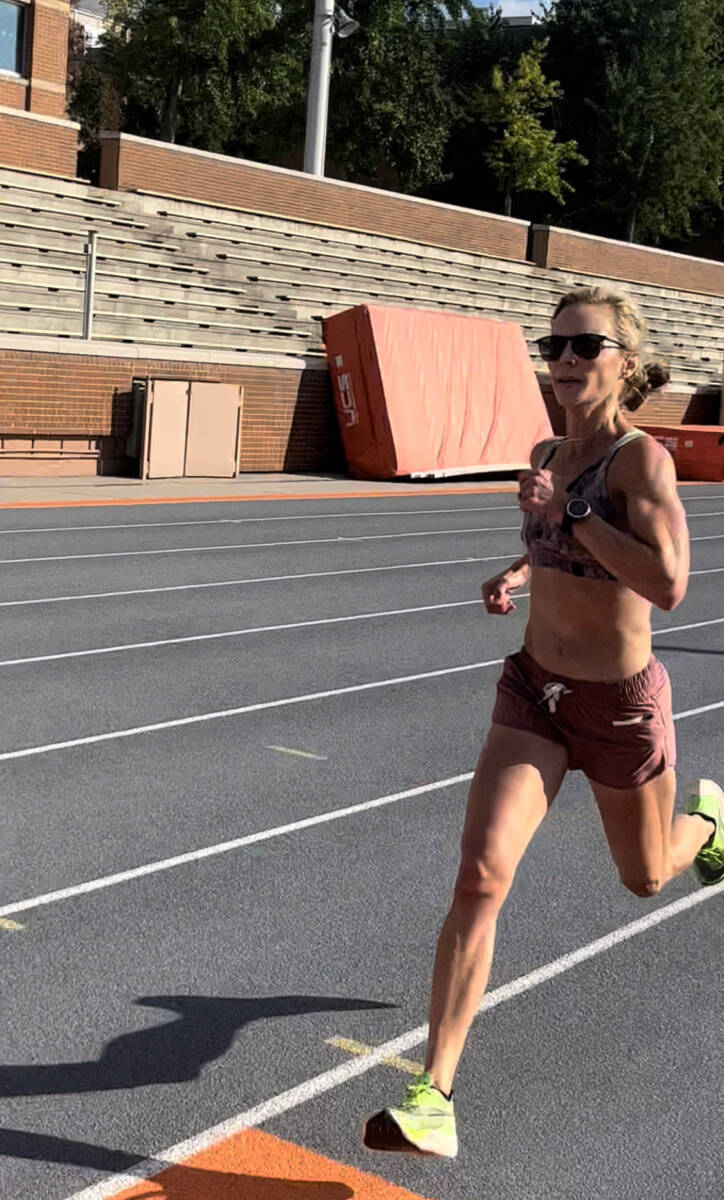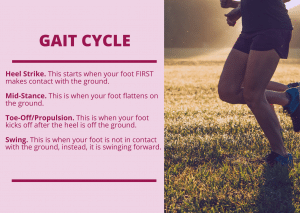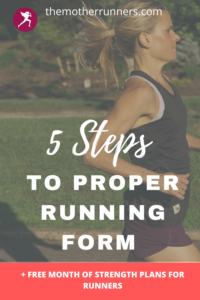Running is a repetitive sport so a tiny imbalance can lead to running injuries. Fixing your running form can help prevent injuries but often times you don’t want to fix what isn’t broken. If you aren’t getting injured often or running feels good, don’t mess with your running gait. If you feel like you have room for improvement, these running drills can only help your running form.

In the past few years, I had dealt with a labral tear on my right hip, a plantar fascia tear on my right foot, a hamstring tear in my right leg…and quad pain…on my right thigh. What the heck is going on with my right side? A visit to a physical therapist’s office to ascertain if I had proper running form revealed pronation of the big toe…on my right.
The lesson here? Running form is key to injury prevention, running efficiency, and achieving your goals. If one thing is off in your form, it can increase your risk of injury and decrease your running economy (how much energy you use to run).
That said, we all have our own unique way to run and there is no best running form. If running is going well for you and you are staying healthy, don’t mess with it! But if you are getting injured a lot, like I did, or know you can run faster for longer distances, tweaking your running form may be a good idea.
In this article, I will offer basic queues for encouraging proper running form that helps you run your best and stay healthy.
Skip Ahead
- Is form important for running?
- Is there a proper way to run?
- So, what is the correct way of running?
- What should my running cadence be?
- How do you land when running?
- How do I know if my running form is correct?
- What is bad running form?
- Common Running Form Mistakes
- How to Fix Running Form
- Step 1: Do a gait analysis.
- Step 2: Focus on one area at a time.
- Step 3: Do exercises to target the imbalances in your gait.
- 7 Exercises to Correct Running Form
- Step 4: Perform this weekly running routine to encourage proper form
- Pre-run:
- During run:
- Post-run:
- Step 5: Reassess your form.
- How long does it take to fix your running form?
Okay, let’s go!
Is form important for running?
Proper running form helps you run efficiently, so you can go faster with less effort and less likelihood of getting injured. Unfortunately, many new runners and experienced runners set out to accomplish big goals only to be sidelined by injuries likely caused by the way they run.
I am a perfect example of this. My natural biomechanics have a slight inversion of my right foot which causes running form changes up my kinetic chain.
Over time, the cumulative effect of the repetitive motion has led to a string of running injuries that have left me sidelined. While healing from my latest injury, I have taken steps to improve my running form which includes strengthening my right glute, elongating my quad, running drills, and custom orthotics for my running shoes.
Related: How to Start Running

Is there a proper way to run?
Everyone has their own running form or running gait. Our bodies are unique and thus, they are going to move differently. We aren’t all going to look like Shalane Flanagan when we run.
And, chances are, you can tell if it is your friend running several hundred yards away just because of their running style.
So, the goal of a runner’s form isn’t for us all to move the same way. The goal is to ensure proper running mechanics so that we are moving our bodies in the most energy-efficient and less impactful way.
Related: Strength Training Guide for Runners
So, what is the correct way of running?
Proper running form is when
- your head is over your shoulders,
- shoulders are over your hips,
- hips are over mid-foot,
- feet are landing under your bent knee (slightly ahead of your center of gravity),
- arms are bent at 90-degrees, relaxed, and swinging near your sides,
- and fingers are lightly placed together like you’re holding one potato chip between your index finger and thumb.
Your steps are quick and soft (cadence is 170-180). Your posture is tall and relaxed, with a slight lean forward. As famed running coach David Roche says, “You’ll look like a beautiful, majestic ostrich.”
Related: How to Run Strides
What should my running cadence be?
Most recreational runners have heard that your running cadence (or the number of times your feet hit the ground in a minute) should be around 180. This is a number pulled from a study of elite runners by the famous running coach Jack Daniels in 1984. However, other studies of elites have found a huge variance of running cadence of 155 to more than 200.
Runners can run the same speed for the same distance and have different running cadences because their stride length can differ as well as their oscillation rates (how much you move vertically when running).
While a 180 running cadence is a good guide for how many times your feet hit the ground while running, it is not the rule. Most runners should focus more on picking their feet off the ground quickly and lightly. Too much ground contact wastes energy and can lead to injury.
For my athletes who need to work on quickening their running cadence, we focus on light quick steps for about 15 minutes in a couple of runs a week.
Other ways to improve cadence is downloading a metronome app on your phone and trying to hit the ground on each beat, listening to songs that have 180 beats per minutes, or counting steps of one foot to hit 90 times per minute. All that requires a lot of focus and takes the joy out of running, so do it just a couple of runs a week.
Related: Kettlebell Workout for Runners
How do you land when running?
A runner’s form should include a foot strike that lands slightly ahead of the runner’s center of gravity (aka the runner’s core). Landing with your feet slightly ahead of your body allows the body to reduce excessive braking of the body and maintain forward momentum.
Most runners land with their feet too far forward (over-striding) and needlessly brake their forward motion with each stride. This is an inefficient way of running.
How do I know if my running form is correct?

You know the saying, if “it ain’t broke, why fix it?” If you’re running pain-free, or mostly pain-free, then there is no need to change your form, says Dr. Jordan Duncan.
“If a runner has recurrent injuries that aren’t responding to conventional treatments, then changes to running form could be helpful,” he says, adding that if the runner would like to increase performance, and have wasted motion or faulty biomechanics while running, then modifying form could be beneficial.
A way to ascertain if your running form needs to be fixed is to have a physical therapist or running coach view a video of you running. Or you can film yourself, says Samantha Clayton, running coach and Olympic sprinter.
“This way you can evaluate your foot placement, body position, and arm swing,” she advises. “You can then get stronger and make mini-changes to correct any imbalances.”
Related: 8 Best Plyometric Moves for Runners
What is bad running form?
There are common form problems for runners that can lead to injury and inefficient running.
Common Running Form Mistakes
- Mistake #1: Heel striking. Your feet shouldn’t lead heel-first in front of your hips, since this will require more effort to push off the ground. Instead, you want to land mid-foot.
- Mistake #2: Tip-toeing. Tip-toeing is when you land on your toes. This also makes it more difficult to push off the ground.
- Mistake #3: Overstriding. The bigger the stride, the faster the runner, right? Nope. Trying to lengthen your stride unnaturally is a surefire way to getting injured because your foot will then land unnaturally ahead of your body. Aim for shorter, faster strides on easy runs. (Stride length increases as your pace increases).
- Mistake #4: Slow cadence. You want your feet hit the ground in quick, light steps. The slower your cadence, the longer your feet are on the ground, and the more energy it takes to lift them up.
- Mistake #5: Stiff upper body. It may sound contradictory to run strong yet loose, but that’s the goal. Ensure your shoulders are dropped away from your ears, and your arms are swinging freely by your side.
- Mistake #6: Crazy arms. Just be careful those arms aren’t swinging excessively. Your arm swing should be by your sides in a smooth, controlled manner.
- Mistake #7: Hunching over or leaning too far forward. Runners should have good running posture by standing tall with your shoulders back. Hunching over is most common when runners are running longer distances and get tired. This crunches your kinetic chain and can lead to injury.
- Mistake #8: Pounding of the feet. Running light is more energy efficient and less impactful on the body.
Should you change your running form?
If you aren’t having injuries or issues, there is no reason to change your running form. Doing so may end up causing injury.
“Sometimes runners will watch videos of other runners or video themselves running, and then they want to change their stride,” says running coach Bobby Holcombe. “Everyone has a different stride, foot strike, etc. They shouldn’t try to change them immediately.”
Instead, focus on simple exercises that will help you gradually improve your posture and become a more efficient runner.
How to Fix Running Form
If you have a sense that you need to fix your running form because of recurring injuries, a sense of an imbalance, or you feel like you could move more efficiently, below are running form tips so you can have a proper running technique.
Step 1: Do a gait analysis.
Have a physical therapist or running coach film you running from different angles and analyze your gait. I did this following my hamstring injury to help get my stride back. It was helpful to learn what imbalances I had.

Alternatively, you can film yourself but you likely lack the knowledge of what to look for and how to address it unless it is a glaring hitch in your step.
After you ascertain what fixes are necessary you can move on to step 2.
Step 2: Focus on one area at a time.
If you are aiming to fix multiple areas with your form, pick one focus each session, then pull it all together, suggests Clayton.
Functional trainer Annie Gibbons has her runners go to a track and run a half-mile with the running form fix and then jog a half-mile without so much concentration on the correction. “This way runners can feel the difference as they repeat this drill. Do it until you become more comfortable with the form, and your body’s muscle memory learns the new way.”
Related: How I Stopped Being Injury Prone
Step 3: Do exercises to target the imbalances in your gait.
There are a plethora of exercises and variations of exercises one can do to fix their running form. The below exercises suggested by running coach Carina Heilner and certified personal trainer Dianne Weisman, along with my own experiences, have been proven to correct running form.
They address three key areas necessary for correct running form:
- Stable platform: Your pelvis acts as the steering wheel for your body. Thus, you must ensure you have a stable platform says Heilner and Weisman. “When we are able to stabilize the pelvis we safeguard ourselves from overuse injuries. We can do this through slow deliberate exercises that re-establish muscle patterns that teach our body to activate transverse abdominals (deep core muscles) and glutes together,” explains Heilner.
- Range of Motion: Mobility is more useful to runners than flexibility. Exercises that improve range of motion allow your body to go farther with every step. I love the MYRTL routine.
- Elasticity: Elasticity of the fascia, the connective tissue that runs between our skin and muscle, enables our muscles and tendons to glide as we move, encouraging a fluid motion. Elasticity is promoted when the muscles are activated in the right order, says Heilner.
7 Exercises to Correct Running Form
The below 7 exercises can address these key areas.
Watch a demonstration for all these exercises for proper running form.
Running Lunge.
Keeping your chest up, step back with your right leg into a reverse lunge. Keeping your back straight, shoulders back, and core engaged, drive through the ball of your left foot to jump straight up, as you raise your right knee to at least hip height and pump your left arm forward and your right arm back. Do 3 x 10 on each side of the running lunge.
Ab Running Cycle.
An ab running cycle is similar to the bicycle crunch except your legs move as if you are running rather than cycling. Lie on your mat with fingertips behind your ears and elbows out. Engage and crunch the core, touching your elbow to the opposite knee while deliberately moving your legs as if you are running. Keep your back flat. Do the ab running cycle for 2 x 1 minute.
Core Strength.
In addition, general core strength exercises help you maintain good posture while running. When you get tired, you slump and excess pressure is put on other parts of your body. A strong core prevents this. Aim to do planks, side planks, bridge, and bicycles 1-2 minutes 2-3 times a week.
Glute Extension or Hip Bridge.
Lie face-up with your knees bent and feet flat on the floor. Engage your core and contract your glutes and lift your hips up to the ceiling. Hold this for 30 seconds to one minute. As this becomes easier, alternate legs, holding each side for 30 seconds to a minute. Progress to a glute extension where you have one foot flat on the floor and one leg extended. Ensure your pelvis is straight and not tilted.

The glute extension teaches the body to engage the glutes when running.
Frog Pose.
The frog pose is a stretch but when done correctly, notes Heilner, it can release the pelvic floor muscles allowing the mobility the pelvis needs to move in good form.
To do it: inhale and slowly move your right and left knee out towards the side as you exhale, stopping to hold and continue breathing whenever you feel the stretch. Do the frog pose after a run or warm-up for 3 x 20 seconds.
Overhead Kettlebell Carry.
Press two kettlebells weights into the overhead position, so that the arms are fully extended, biceps are by the ears, and the wrists are neutral. Lock shoulder blades in place and engage your core. Take one small step focusing on maintaining straight arms. Stabilize the weight with the upper and middle back.
The overhead kettlebell carry teaches the body to engage the transverse abdominals while in a standing position, and in order to engage those abdominals you must release and recruit the pelvic floor to create space for the transverse abdominals to engage, says Heilner.
Wall Sprint Drill.
Your head, shoulders, hips, knees, and ankles should always be aligned, with your body positioned in a 45-degree angle to the ground. Drive knees up. Do it slow and fast. The wall sprint drill ensures proper running technique.
Step 4: Perform this weekly running routine to encourage proper form

Perform these actions to improve running form and maintain it.
Pre-run:
- Dynamic stretching & mobility. Dynamic stretching includes active movements like lunges and leg swings where joints and muscles go through a full range of motion. Mobility routines such as Jay Johnson’s MYRTL improve mobility and fire the appropriate muscles before your workout. Aim to do them before a run.
- Drills. Speed drills improve form by improving communication between your brain and legs to help you become more efficient. The most common drills for runners include high knees, side shuffle, A-Skip, butt-kicks, straight leg bounds, backward running, high knee butt kick, and carioca. Do each drill for 20 meters two times a week after a warm-up. Watch my video of running drills here. View these drills here.
Related: Speed Drills for Runners
During run:
- Barefoot running. Running without shoes strengthens your feet and leg muscles and teaches your body to land mid-foot. Jog in place or on soft grass for a minute four times. Do this twice a week.
- Perform mental checks. During your run, running coach Patrick Gildea says to run down a mental checklist to see if your form is correct. Ask yourself if you’re running tall with relaxed shoulders, chin down, eyes ahead, and fingertips at your waist.
“These are simple cues that you can use to remind yourself during the difficult stages of a run or race to get you back on point,” explains Gildea.
Post-run:
Strides. Two to four times a week, end a run doing four to six strides of 80-100 meters. Strides are where you run progressively faster so that you’re at top speed (mile pace) in the middle of the distance. Strides help your body mechanics by teaching it how to run fast. Personally, strides were a gamechanger for me in correcting my form post-injury.
Jump rope. Jumping rope strengthens the muscles needed to bound off the ground quickly—without the impact on your joints. Aim to do a set of 100 rotations twice a week (after an easy run) to see an improvement.
Step 5: Reassess your form.
Every month, film yourself running to check your form and see if you notice a change in your gait. All these exercises combine to make your body stronger and balanced.
How long does it take to fix your running form?
This may seem like a lot to do to but they are small steps that most well-rounded runners do to stay healthy and perform better. After a month, runners will begin to see and feel an improvement in their running form.
How empowering to know that we can change and be better runners without wearing ourselves out or getting hurt?
If you want guidance with your running goals, check out my run coaching services. Also, be sure to check out my free training plans:
